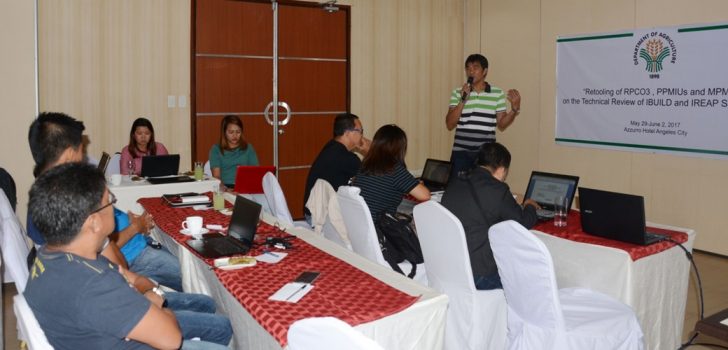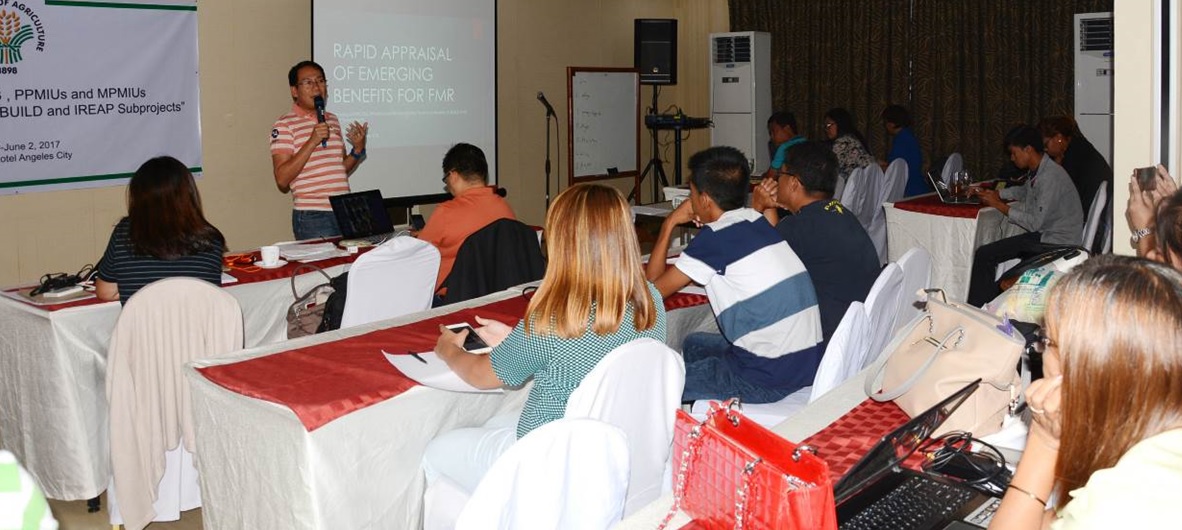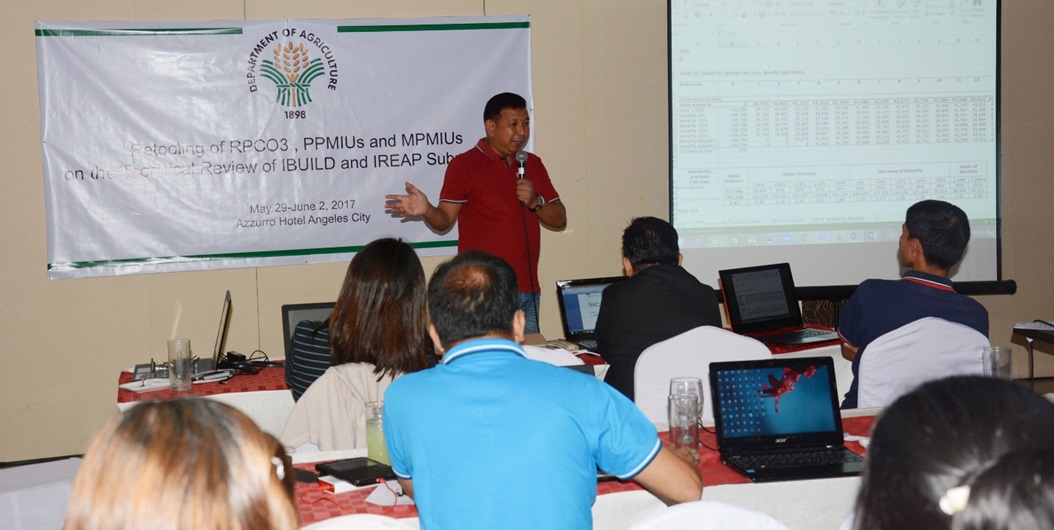 Mr. Gil David, Regional Project Coordination Office 3 Alternate Focal Person, explains to the participants the importance of the retooling training on Technical review of I-BUILD and I-REAP subprojects
Mr. Gil David, Regional Project Coordination Office 3 Alternate Focal Person, explains to the participants the importance of the retooling training on Technical review of I-BUILD and I-REAP subprojects C.Luzon conducts retooling training on technical reviews of I-REAP and I-BUILD subprojects
Angeles City, Pampanga – To equip the implementing units of Central Luzon with updated knowledge on the use of enhanced PRDP templates, the Regional Project Coordination Office 3 (RPCO 3) of the Philippine Rural Development Project (PRDP) conducted a Retooling Training on May 29- to June 2, attended by different Provincial Project Management Implementing Units (PPMIUs) and Municipal Project Management Implementing Units (MPMIUs).
The training was intended to capacitate the regional and provincial staffs with better schemes in determining the status of the subprojects within the region. It also aimed to regulate the submission of forms and documents necessary for the implementation and monitoring of the subprojects.
PRDP Luzon A Cluster Director Roy M. Abaya encouraged the participants to continue with their active participation with the Project, for the welfare of the farmers and fisher folk in Central Luzon.
According to him, the North Luzon Cluster has the highest financial performance in terms of I-BUILD subprojects’ cash disbursement which is 64%. For the overall per region, Region 3 has the highest in terms of I-BUILD cash disbursement which is 94%.
“However, let us not rely on those numbers because we are far away from the finish line of our projects,” said Abaya.
“Let us help one another to have a fast and good implementation of our subprojects in our cluster. We need to exert more effort and follow the guidelines, processes and standards written on our manuals in order to fasten the implementation of the subprojects,” he added.
RPCO3 Alternate Focal Person Gil David explained that the said training is essential for aiding the staff in preparing the documents needed for the proposed subprojects, for fastening the approval of subprojects.
“For the I-REAP subprojects we have an agreement that after RPAB, the NOL 1 will be issued after one month. Meaning before the RPAB meeting, the business plan should be clear and free of any comments especially on the technical side,” he said.
RPCO3 Focal Person Crispulo Bautista also attended the said activity and encouraged the participants to use the training in their different local government units.
“I urge you to use the lessons that you learned on this training to your respective units as a basis in preparing your subprojects proposals,” Bautista said.
Refresher courses for smoother implementation
PSO Economist James Sabio served as the resource speaker of the training. One of his presentations is the Review Guidelines on Financial Analysis for I-REAP subprojects which aims to create a common understanding on the basic concepts and guidelines in the preparation and review of financial analysis, to strengthen basis of assumptions in preparing financial projections, to come up with more sound financial viability indicators and to enhance review process and help facilitate approval of subprojects.
He likewise tackled the economic and financial indicators under the enterprise level and farmer level.
“For the enterprise level, the enterprise should be earning enough to sustain its operations and can generate employment. When it comes to farmer level, the PRDP is interested to see the increase in income of the farmers which is 5% increase per year,” he said.
RPCO3 Monitoring and Evaluation Officer June Lacasandile presented the Rapid Appraisal of Emerging Benefits for FMR and I-REAP subprojects.
“During the exit conference of M&E Unit last World Bank Support Mission, the WB said that they are more concerned about the impact of the PRDP subprojects to the targeted beneficiaries rather than the number of subprojects approved,” he said.
One of the objectives of the RAEB is to determine the other socio-economic benefits after the completion of subproject and its impact to the community.
The Retooling Training was done to have a better way in evaluating the attainment of the Project Development Objectives, such as having a 5% increase in annual real farm income, 7% increase in annual market output, 20% increase in number of farmers and fishers with improved access to the services of the Department of Agriculture, and a 30% increase in incomes of targeted beneficiaries. (Dianne M. Lapuz, DA-PRDP RPCO3-InfoACE)

Mr. June Lacasandile, Monitoring and Evaluation Officer of Regional Project Coordination Office 3, presents the Rapid Appraisal of Emerging Benefits for farm-to-market roads.

Mr. James Sabio, PSO Luzon A Economist, presents the Guidelines on Financial Analysis for I-REAP subprojects to the PPMIUs and MPMIUs during the retooling training.
